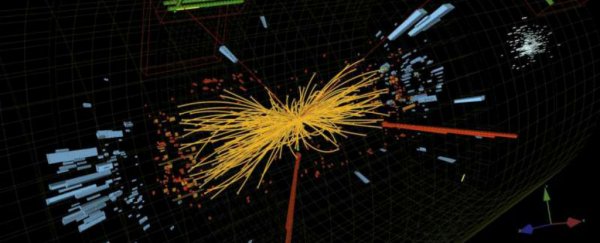Physicists have discovered signals of a new particle in the swathes of data used to confirm the existence of the Higgs boson back in 2012, and have tentatively named it the Madala boson.
The signal was first detected in data from the 2012 Large Hadron Collider (LHC) experiments at CERN, and has now been supported by repeat experiments in 2015 and 2016. Nothing's confirmed just yet, but the case is getting stronger.
The group behind the discovery, the High Energy Physics Group (HEP) from the University of the Witwatersrand in South Africa, suggest that if their 'Madala hypothesis' is correct, it could help us make sense of dark matter's place in the Universe.
Estimated to make up around 27 percent of all the mass and energy in the observable Universe, we know dark matter exists because we can detect its gravitational force, but it doesn't appear to emit any form of light or radiation that we can observe.
And despite years of searching, no one actually knows what dark matter actually is - the closest we've gotten to figuring that out is crossing off each potential candidate one by one.
"Physics today is at a crossroads similar to the times of Einstein and the fathers of Quantum Mechanics," says lead researcher, Bruce Mellado.
"Classical physics failed to explain a number of phenomena and, as a result, it needed to be revolutionised with new concepts, such as relativity and quantum physics, leading to the creation of what we know now as modern physics."
When the existence of the Higgs boson was confirmed in 2012, it finally completed the Standard Model of Physics. But as complete as it now is, the Standard Model can't explain the existence or behaviour of dark matter - which is where the heavier Madala boson comes in (if it's real).
Mellado and his team explain that while the Higgs boson only interacts with known matter - which makes up just 4 percent of the mass and energy of the Universe - the Madala boson appears to interact with dark matter instead.
Details about the discovery are piecemeal right now, but have been outlined in the South African Scientific Collaboration With CERN's 2015-2016 Annual Report, which describes the hypothesised Madala boson as having a mass of around 270 giga electronvolts (GeV) - or roughly 270 billion electron volts.
To put that into perspective, the Higgs boson has a mass of around 126 GeV.
The same 2015 to 2016 experiments that strengthened the case for the Madala boson also showed indications of an even heavier potential new boson, which weighs in at a whopping 750 GeV (if it's real).
You can see the evidence for the Madala boson on the left below, and for the heavier boson on the right:
 South African Collaboration With CERN
South African Collaboration With CERN
We're going to have to wait for the teams behind these discoveries to come up with more evidence and then give the rest of the physics community a chance to scrutinise them, but if - and that's a big if - they can turn up more evidence, the implications would be significant.
As the South African Collaboration With CERN explains:
"The significance of the discovery of new bosons goes beyond that of the Higgs boson. The Higgs boson was needed to complete the Standard Model of Particle Physics. However, this boson did not signify the discovery of a new force or family of particles.
The discovery of new bosons would be evidence for forces and particles formerly unknown. Therefore, and without a reasonable doubt, the discovery of new bosons would be worth a Nobel Prize in Physics."
Update: We previously mentioned that the report cited in this story was from CERN, and have corrected the article to reflect that it was from the South African Collaboration With CERN. CERN has commented today to confirm that the particle remains hypothetical without further evidence:
Sorry guys, but there is no evidence so far in the #LHC data to support the existence of a hypothetical #Madala #boson
— CERNpress (@CERNpress) September 7, 2016
